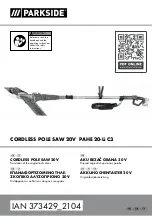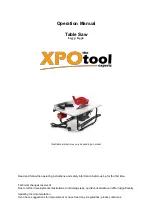
3
f. If devices are used for dust extraction and collection, make sure they are
properly connected. Properly use these devices and you will reduce dust-
related hazards.
g. Maintain posture and balance at all times. This allows for better control of
the power tool in unexpected situations.
4) Use and care of power tools
a. Do not force the tool. Use the correct power tool for each use.
b. Do not use the power tool if its power switch does not work. Any power
tool that cannot be controlled with the switch is dangerous and must be
repaired.
c. Disconnect the plug from the power source before making any
adjustments, changing accessories, or storing the tool to avoid accidental
starting of the tool.
d. Use the power tool, accessories and bits etc. in accordance with these
instructions, taking into account the working conditions and the work to
be carried out. Using the power tool for operations other than those
intended could result in a hazardous situation.
e. Store power tools out of the reach of children and do not allow people
unfamiliar with the tool to use it.
f. Keep power tools in good condition. Check for misalignment or binding of
moving parts, breakage of parts, and any other conditions that may affect
the operation of power tools. If it is damaged, have the power tool repaired
before using it. Many accidents are caused by poorly maintained power
tools.
g. Keep cutting tools sharp and clean. Properly maintained cutting tools with
sharp cutting edges are less likely to bind and are easier to control.
5) Battery use and care
a) Recharge the battery only with the charger specified by the manufacturer.
An unsuitable charger can create a fire hazard.
b) Use specifically designated batteries. Use of other batteries may create a
risk of injury or fire.
c) When the batteries are not in use, keep it away from other metal objects,
such as paper clips, coins, keys, nails, screws, or other small metal
objects, that can make a connection from one terminal to another.
Shorting the battery terminals can cause burns or fire.
d) Abusive conditions can cause expulsion of liquid from the battery; avoid
contact. If accidentally contacted, rinse immediately with water. If the
liquid comes into contact with the eyes, also seek medical help. Liquid
expelled from the battery can cause irritation or burns.
e) Do not use a battery or tool that is damaged or modified. They may exhibit
unpredictable behavior resulting in fire, explosion, or risk of injury.
f) Do not expose a battery or tool to fire or excessive heat. Exposure to fire
or temperature above 130°C may cause an explosion.
g) Follow all charging instructions. Do not charge the battery or tool outside
the temperature range specified in the instructions. Improper charging or
charging at temperatures outside the specified range may damage the
battery or increase the risk of fire.
6) Service
Summary of Contents for TRSLI1151
Page 1: ...1 SABER SAW ON BATTERY ...
Page 13: ...13 SABER BATTERY SAW ...































